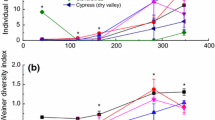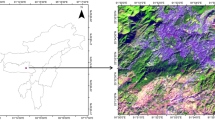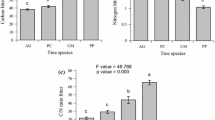Abstract
Foliar nutrient resorption (FNR) is a key process in the dynamics of nutrients in a forest ecosystem. Along with other factors, FNR regulates the chemical composition of the forest floor and, consequently, the rates of organic matter decomposition and soil nutrient availability. The main objective of the present study was to examine the effect of FNR of two deciduous oak species (Quercus castanea and Q. deserticola) in the litter and soil nutrient dynamics, in addition to analyze whether the interaction between two species was positive (synergistic) or negative (antagonistic) through the mixed litter from two species. For this purpose, the nutrient concentration of green leaves, litterfall, litter and soil was measured, as well as soil microbial activity. These measurements were taken in isolated stands with the presence of one of the oak species and stands with the two oak species mixed. Quercus deserticola, with lower FNR, produced litter with a higher N concentration, which apparently enhancing microbial activity in the forest floor litter and increased nutrient transformations and soil fertility. In contrast, Q. castanea has a higher FNR and produced litter with a lower nutrient concentration. The microbial soil community associated with Q. castanea must therefore invest more energy in metabolic processes at the expense of biomass growth. However, forest floor nutrient transformations were more intense and soil fertility increased in areas where both species intermix; in this case, the latter species received the rich-nutrient litterfall of Q. deserticola. These results suggest a strong footprint of species traits on microbial activities and soil nutrient transformations.



Similar content being viewed by others
References
Aerts R (1996) Nutrient resorption from senescing leaves of perennials: are there general patterns? J Ecol 84:597–608
Aksekili E, Kilic DD, Kutbay HG (2007) Foliar nutrient dynamics and foliar resorption in Quercus brantii lindley along an elevational gradient. Pak J Biol Sci 10:3778–3785
Aldrich PR, Cavender-Bares J (2011) Quercus. In: Kole C (ed) Wild crop relatives: genomic and breeding resources, forest trees. Springer, Berlin, pp 89–129
Almendros G, Dorado J, González-Villa FJ, Blanco MJ, Lankes U (2000) 13C NMR assessment of decomposition patterns during composting of forest and shrub biomass. Soil Biol Biochem 32:793–804
Aponte C, Marañón T, García LV (2010) Microbial C, N and P in soils of Mediterranean oak forests: influence of season, canopy cover and soil depth. Biogeochemistry 101:77–92
Aponte C, García LV, Pérez-Ramos IM, Gutiérrez E, Marañón T (2011) Oak trees and soil interactions in Mediterranean forests: a positive feedback model. J Veg Sci 22:856–867
Aponte C, García LV, Marañón T (2013) Tree species effects on nutrient cycling and soil biota: a feedback mechanism favoring species coexistence. Forest Ecol Manag 309:36–46
Bengtsson G, Bengtson P, Mansson K (2003) Gross nitrogen mineralization-, immobilization-, and nitrification rates as a function of soil C/N ratio and microbial activity. Soil Biol Biochem 35:143–154
Berg B, McClaugherty C (2014) Plant litter: decomposition, humus formation, carbon sequestration, 3rd edn. Springer, Berlin
Berrier DJ, Rawls MS, McCallister SL, Franklin RB (2014) Influence of substrate quality and moisture availability on microbial communities and litter decomposition. Open J Ecol 4:421–433
Blagodatskaya E, Khomyakov N, Myachina O, Bogomolova I, Blagodatsky S, Kuzyakov Y (2014) Microbial interactions affect sources of priming induced by cellulose. Soil Biol Biochem 74:39–49
Bonanomi G, Incerti G, Antignani V, Capodilupo M, Mazzoleni S (2010) Decomposition and nutrient dynamics in mixed litter of Mediterranean species. Plant Soil 331:481–496
Bonanomi G, Incerti G, Giannino F, Mingo A, Lanzotti V, Mazzoleni S (2013) Litter quality assessed by solid state13C NMR spectroscopy predicts decay rate better than C/N and Lignin/N ratios. Soil Biol Biochem 56:40–48
Bremmer JM (1996) Nitrogen-total. In: Spark DL, Page AL, Summer ME, Tabatabai MA, Helmke PA (eds) Methods of soil analyses part 3: chemical analyses. Soil Science Society of America, Madison, pp 1085–1121
Brookes PC, Powlson DS, Jenkinson DS (1984) Phosphorus in the soil microbial biomass. Soil Biol Biochem 16:169–175
Campanella MV, Bertiller MB (2011) Is N-resorption efficiency related to secondary compounds and leaf longevity in coexisting plant species of the arid Patagonian Monte, Argentina? Austral Ecol 36:395–402
Cavender-Bares J, Ackerly DD, Baum DA, Bazzaz EA (2004) Phylogenetic over dispersion in Floridian oak communities. Am Nat 163:823–843
Chapman SK, Newman GS (2010) Biodiversity at the plant-soil interface: microbial abundance and community structure respond to litter mixing. Oecologia 162:763–769
Chapman SK, Newman GS, Hart SC, Schweitzer JA, Koch GW (2013) Leaf litter mixtures alter microbial community development: mechanisms for non-additive effects in litter decomposition. PLoS ONE 8:e62671
Chávez-Vergara B (2010) Efecto de dos especies del genero Quercus sobre la dinámica de C, N y P en un fragmento forestal de la cuenca de Cuitzeo, Michoacán. (MSc Thesis) UNAM, Morelia, México
Chávez-Vergara B, García-Oliva F (2013) Consecuencias funcionales de la diferenciación taxonómica entre secciones del género Quercus: el caso de la reabsorción de nutrientes. Revista Biológicas Número Especial, pp 1–7
Chávez-Vergara B, Merino A, Vázquez-Marrufo G, García-Oliva F (2014) Organic matter dynamics and microbial activity during decomposition of forest floor under two native Neotropical oak species in a temperate deciduous forest in Mexico. Geoderma 235–236:133–145
Cleveland CC, Neff JC, Townsend AR, Hood E (2004) Composition, dynamics, and fate of leached dissolved organic matter in terrestrial ecosystems: results from a decomposition experiment. Ecosystems 7:275–285
Cleveland CC, Reed SC, Keller AB, Nemergut DR, O’Neill SP, Ostertag R, Vitousek PM (2014) Litter quality versus soil microbial community controls over decomposition: a quantitative analysis. Oecologia 174:283–294
Couteaux MM, Bottner P, Berg B (1995) Litter decomposition, climate and litter quality. Trends Ecol Evol 10:63–66
Covelo F, Gallardo A (2002) Effect of pine harvesting on leaf nutrient dynamics in young oak trees at NW Spain. For Ecol Manag 167:161–172
Covelo F, Rodríguez A, Gallardo A (2008) Spatial pattern and scale of leaf N and P resorption efficiency and proficiency in a Quercus robur population. Plant Soil 311:109–119
de Campos MC, Pearse SJ, Oliveira RS, Lambers H (2013) Down regulation of net phosphorus-uptake capacity is inversely related to leaf phosphorus-resorption proficiency in four species from a phosphorus-impoverished environment. Ann Bot 111:445–454
del Arco JM, Escudero A, Vega-Garrido M (1991) Effects of site characteristics on nitrogen retranslocation from senescing leaves. Ecology 72:701–708
Don A, Kalbitz K (2005) Amounts and degradability of dissolved organic carbon from foliar litter at different decomposition stages. Soil Biol Biochem 37:2171–2179
Drenovsky RE, Koehler CE, Skelly K, Richards JH (2013) Potential and realized nutrient resorption in serpentine and non-serpentine chaparral shrubs and trees. Oecologia 171:39–50
Duboc O, Zehetner F, Djukic I, Tatzber M, Berger TW, Gerzabek MH (2012) Decomposition of European beech and Black pine foliar litter along an Alpine elevation gradient: mass loss and molecular characteristics. Geoderma 189–190:522–531
Eaton WD (2001) Microbial and nutrient activity in soils from different subtropical forest habitat in Belize, Central America before and during the transition from dry to wet season. App Soil Ecol 16:219–227
Escudero A, Mediavilla S (2003) Decline in photosynthetic nitrogen use efficiency with leaf age and nitrogen resorption as determinants of leaf life span. J Ecol 91:880–889
Fanin N, Hättenschwiler S, Fromin N (2014) Litter fingerprint on microbial biomass, activity, and community structure in the underlying soil. Plant Soil 379:79–91
Fierer N, Bradford MA, Jackson RB (2007) Toward and ecological classification of soil bacteria. Ecology 88:1354–1364
Freschet GT, Aerts R, Cornelissen JHC (2012) Multiple mechanisms for trait effects on litter decomposition: moving beyond home-field advantage with a new hypothesis. J Ecol 100:619–630
García-Oliva F, Sveshtarova B, Oliva M (2003) Seasonal effects on soil carbon dynamics in a tropical deciduous forest ecosystem in Western Mexico. J Trop Ecol 19:179–188
Gartner TB, Cardon ZG (2004) Decomposition dynamics in mixed-species leaf litter. Oikos 104:230–246
Genung MA, Bailey JK, Schweitzer JA (2013) The afterlife of interspecific indirect genetic effects: genotype interactions alter litter quality with consequences for decomposition and nutrient dynamics. PLoS ONE 8:e53718
Hagen-Thorn A, Varnagiryte I, Nihlgård B, Armolaitis K (2006) Autumn nutrient resorption and losses in four deciduous forest tree species. For Ecol Manag 228:33–39
Hayes P, Turner BL, Lambers H, Laliberté E, Bellingham P (2014) Foliar nutrient concentrations and resorption efficiency in plants of contrasting nutrient-acquisition strategies along a 2-million-year dune chronosequence. J Ecol 102:396–410
Huffman EWD (1977) Performance of a new carbon dioxide coulometer Microchem. J. 22:567–573
Jiang C, Yu G, Li Y, Cao G, Yang Z, Sheng W, Yu W (2012) Nutrient resorption of coexistence species in alpine meadow of the Qinghai-Tibetan Plateau explains plant adaptation to nutrient-poor environment. Ecol Eng 44:1–9
Joergensen RG, Mueller T (1996) The fumigation-extraction method to estimate soil microbial biomass: calibration of the KEN value. Soil Biol Biochem 28:33–37
Jones DL, Willett VB (2006) Experimental evaluation of methods to quantify dissolved organic nitrogen (DON) and dissolved organic carbon (DOC) in soil. Soil Biol Biochem 38:991–999
Jones DL, Willett VB, Stockdale EA, Macdonald AJ, Murphy DV (2012) Molecular weight of dissolved organic carbon, nitrogen, and phenolics in Grassland Soils. Soil Sci Soc Am J 76:142–150
Kaye JP, Resh SC, Kaye MW, Chimner RA (2000) Nutrient and carbon dynamics in a replacement series of Eucalyptus and Albizia trees. Ecology 81:3267–3275
Kiikkilä O, Kanerva S, Kitunen V, Smolander A (2013) Soil microbial activity in relation to dissolved organic matter properties under different tree species. Plant Soil 377:169–177
Kilic D, Kutbay HG, Ozbucak T, Huseyinova R (2010) Foliar resorption in Quercus petraea subsp. iberica and Arbutus andrachne along an elevational gradient. Ann For Sci 67:213
Killingbeck KT (1996) Nutrients in senesced leaves: keys to the search for potential resorption and resorption proficiency. Ecology 77:1716–1727
Killingbeck KT (2004) Nutrient resorption. In: Noodén LD (ed) Plant cell death processes. Academic Press, New York, pp 215–226
Killingbeck KT, Costigan SA (1988) Element resorption in a guild of understory shrub species: niche differentiation and resorption thresholds. Oikos 53:366–374
Knops JMH, Koenig WD (1997) Site fertility and leaf nutrients of sympatric evergreen and deciduous species of Quercus in central coastal California. Plant Ecol 130:121–131
Kominoski JS, Hoellein TJ, Kelly JJ, Pringle CM (2009) Does mixing litter of different qualities alter stream microbial diversity and functioning on individual litter species? Oikos 118:457–463
Körner C (1989) The nutritional status of plants from high altitudes. A worldwide comparison. Oecologia 81:379–391
Kozovits AR, Bustamante MMC, Garofalo CR, Bucci S, Franco AC, Goldstein G, Meinzer FC (2007) Nutrient resorption and patterns of litter production and decomposition in a Neotropical savanna. Func Ecol 21:1034–1043
Kuzyakov Y (2010) Priming effects: interactions between living and dead organic matter. Soil Biol Biochem 42:1363–1371
Lajtha K, Klein M (1988) The effect of varying nitrogen and phosphorus availability on nutrient use by Larrea tridentata, a desert evergreen shrub. Oecologia 75:348–353
Lecerf A, Marie G, Kominoski JS, LeRoy CJ, Bernardet C, Swan CM (2011) Incubation time, functional litter diversity, and habitat characteristics predict litter-mixing effects on decomposition. Ecology 92:160–169
Levy-Booth DJ, Prescott CE, Grayston SJ (2014) Microbial functional genes involved in nitrogen fixation, nitrification and denitrification in forest ecosystems. Soil Biol Biochem 75:11–25
Li LJ, Zeng D-H, Mao R, Yu ZY (2012) Nitrogen and phosphorus resorption of Artemisia scoparia, Chenopodium acuminatum, Cannabis sativa, and Phragmites communis under nitrogen and phosphorus additions in a semiarid grassland, China. Plant Soil Environ 58:446–451
Luizao RCC, Bone TA, Rosswall T (1992) Seasonal variation of soil microbial mass. The effect of clear felling a tropical rainforest and establishment of pasture in the Central Amazon. Soil Biol Biochem 24:805–813
Mae T (2004) Leaf senescence and nitrogen metabolism. In: Noodén LD (ed) Plant cell death processes. Academic Press, New York, pp 157–168
McArthur JV, Aho JM, Rader RB, Mills GL (1994) Interspecific leaf interactions during decomposition in aquatic and flood plain ecosystems. J N Am Benthol Soc 13:57–67
Medina E, Cuevas E (1994) IV. Mineral nutrition: humid tropical forests. Prog Bot 55:115–129
Montaño NM, García-Oliva F, Jaramillo VJ (2007) Dissolved organic carbon affects soil microbial activity and nitrogen dynamics in a Mexican tropical deciduous forest. Plant Soil 295:265–277
Montaño NM, Sandoval-Pérez AL, García-Oliva F, Larsen J, Gavito ME (2009) Microbial activity in contrasting conditions of soil C and N availability in a tropical dry forest. J Trop Ecol 25:401–413
Murphy J, Riley JP (1962) A modified single solution method for the determination of phosphate in natural waters. Anal Chim Acta 27:31–36
Nilsson M-C, Gallet C, Wallstedt A (1998) Temporal variability of phenolics and batatasin-III in Empetrum hermaphroditum leaves over an eight-year period: interpretation of ecological function. Oikos 81:6–16
Ono K, Hiradate S, Morita S, Hirai K (2011) Fate of organic carbon during decomposition of different litter types in Japan. Biogeochemistry 112:7–21
Orwin K, Wardle D, Greenfield L (2006) Ecological consequences of carbon substrate identity and diversity in a laboratory study. Ecology 87:580–593
Osono T, Hirose D, Fujimaki R (2006) Fungal colonization as affected by litter depth and decomposition stage of needle litter. Soil Biol Biochem 38:2743–2752
Perveen N, Barot S, Alvarez G, Klumpp K, Martin R, Rapaport A, Herfurth D, Louault F, Fontaine S (2014) Priming effect and microbial diversity in ecosystem functioning and response to global change: a modeling approach using the SYMPHONY model. Glob Chang Biol 20:1174–1190
Pietsch KA, Ogle K, Cornelissen JHC, Cornwell WK, Bönisch G, Craine JM, Jackson BG, Kattge J, Peltzer DA, Penuelas J, Reich PB, Wardle DA, Weedon JT, Wright IJ, Zanne AE, Wirth C (2014) Global relationship of wood and leaf litter decomposability: the role of functional traits within and across plant organs. Glob Ecol Biogeogr 23:1046–1057
Reich PB, Wright IJ, Cavender-Bares J, Craine JM, Oleksyn J, Westoby M, Walters MB (2003) The evolution of plant functional variation: traits, spectra, and strategies. Int J Plant Sci 164:143–164
Renteria LY, Jaramillo VJ (2011) Rainfall drives leaf traits and leaf nutrient resorption in a tropical dry forest in Mexico. Oecologia 165:201–211
Robertson PG, Coleman DC, Bledsoe CS, Sollins P (1999) Standard soil methods for long-term ecological research (LTER). University Press, Oxford, pp 258–271
Rodríguez-Trejo DA, Myers RL (2010) Using oak characteristics to guide fire regime restoration in Mexican pine-oak and oak forests. Ecol Res 28:304–323
Salamanca EF, Kaneko N, Katagiri S (1998) Effects of leaf litter mixtures on the decomposition of Quercus serrata and Pinus densiflora using field and laboratory microcosm methods. Ecol Eng 10:53–73
SAS Institute Inc (2010) JMP software Version 11 www.jmp.com
Shaver GR, Melillo JM (1984) Nutrient budgets of marsh plants: efficiency concept and relation to availability. Ecology 65:1491–1510
Smith VC, Bradford MA (2003) Do non-additive effects on decomposition in litter-mix experiments result from differences in resource quality between litters? Oikos 102:235–242
Smolander A, Kitunen V (2002) Soil microbial activities and characteristics of dissolved organic C in relation to tree species. Soil Biol Biochem 34:651–660
Sokal RR, Rohlf FJ (1995) Biometry. Freeman and Company, San Francisco, p 832
Sparling GP, Feltham CW, Reynolds J, West AW (1990) Estimation of soil microbial C by a fumigation–extraction method: use on soils of high organic matter content, and a reassessment of the KEC-factor. Soil Biol Biochem 22:301–307
StatSoft Inc (2007) STATISTICA (data analysis software system) version 8.0. www.statsoft.com
Talbot JM, Yelle DJ, Nowick J, Treseder KK (2011) Litter decay rates are determined by lignin chemistry. Biogeochemistry 108:279–295
Tang L, Han W, Chen Y, Fang J (2013) Resorption proficiency and efficiency of leaf nutrients in woody plants in eastern China. J Plant Ecol 6:408–417
Technicon (1977) Technicon industrial system. Method No. 329–74 W/B Individual/simultaneous determinations of nitrogen and/or phosphorus in BD acid digest. Technicon Industrial Systems, New York
Thirukkumaran CM, Parkinson D (2000) Microbial respiration, metabolic quotient and litter decomposition in a lodge pole pine forest floor amended with nitrogen and phosphorous fertilizers. Soil Biol Biochem 32:59–66
Tiessen H, Moir JO (1993) Characterization of available P by sequential extraction. In: Carter MR (ed) Soil sampling and methods of analysis. Lewis Publishers, Boca Raton, pp 75–85
Ueda MU, Mizumachi E, Tokuchi N (2011) Foliage nitrogen turnover: differences among nitrogen absorbed at different times by Quercus serrata saplings. Ann Bot 108:169–175
Van Meeteren MJM, Tietema A, Westerveld JW (2007) Regulation of microbial carbon, nitrogen, and phosphorus transformations by temperature and moisture during decomposition of Calluna vulgaris litter. Biol Fert Soils 44:103–112
Vance ED, Brookes AC, Jenkinson DS (1987) An extraction method for measuring soil microbial biomass C. Soil Biol Biochem 19:703–707
Vitousek PM, Turner DR, Kitayama K (1995) Foliar nutrients during long-term soil development in Hawaiian montanera in forest. Ecology 76:712–720
Von Ende CN (1993) Repeated measures analysis: growth and other time-dependent measures. In: Scheiner SM, Gurevitch J (eds) Design and analysis of ecological experiments. Chapman and Hall, New York, pp 113–137
Wardle D, Yeates G, Barker G, Bonner K (2006) The influence of plant litter diversity on decomposer abundance and diversity. Soil Biol Biochem 38:1052–1062
Wu T, Dong Y, Yu M, Geoff Wang G, Zeng D-H (2012) Leaf nitrogen and phosphorus stoichiometry of Quercus species across China. For Ecol Manag 284:116–123
Acknowledgments
We are grateful to Ramiro Ríos for assisting with the collection of samples, and Rodrigo Velázquez-Durán and Ofelia Beltrán Paz for assisting with chemical analysis. We thank two anonymous reviewers for comments on a draft of the manuscript. This study was partially supported by PAPIIT-DGAPA, UNAM (project no. IV201015). B. Chávez-Vergara acknowledges a scholarship provided by the National Council of Science and Technology (CONACyT, scholarship number 215406) and support from the Graduate Program in Biological Sciences of the National Autonomous University of Mexico (UNAM).
Ethical Standard
The present article has been approved by all co-authors, and it has not been previously published nor is in consideration for publication elsewhere. The authors declare that they have no conflict of interest; additionally, this research is not involving human participants and/or animals.
Author information
Authors and Affiliations
Corresponding author
Additional information
Communicated by Hans Pretzsch.
Electronic supplementary material
Below is the link to the electronic supplementary material.
Rights and permissions
About this article
Cite this article
Chávez-Vergara, B.M., González-Rodríguez, A., Etchevers, J.D. et al. Foliar nutrient resorption constrains soil nutrient transformations under two native oak species in a temperate deciduous forest in Mexico. Eur J Forest Res 134, 803–817 (2015). https://doi.org/10.1007/s10342-015-0891-1
Received:
Revised:
Accepted:
Published:
Issue Date:
DOI: https://doi.org/10.1007/s10342-015-0891-1




